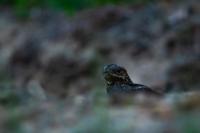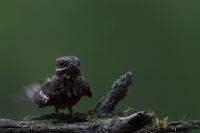I could not expect to photograph this bird in Turkey. On the first day when I arrived, and after only two hours of sleep I had to get up at night to go to the lookouts. Along the road, actually on the road we passed three nightjars. We had a small delay and there was no time to stop to take my first photos of the nightjar. Yes, there on this sandy-stony road we passed nightjars that did not really evade. The driver drove very carefully as he did not want to knock down the birds. I decided to get up half an hour earlier the next day and try to take pictures. Nightjars of course appeared but on the asphalt road unluckily and the time spent on a photo session passed very quickly. It is interesting that the bird frightened by traffic and car lights flew away, but when the car back up a few meters and the engine was turned off the european nightjar returned to the same place, even though it still was in the lights of the car. That is how my first picture of the european nightjar was taken, and it was the first of nature photography where the artificial lighting was used. It was the only way to do it as seeking the European nightjar in daylight seems to be impossible. It leads nightlife so otherwise it is not possible to overcome the difficulties in capturing live nightjar. The bird presented in the light of the sun is a dead one. We found it on the street when we were going to the place where we wanted to photograph Egyptian vulture. There was a small chance for another photo and in this case there was no way to help, so it was a unique opportunity to show details of its plumage. As mysterious, and peculiar the bird so specific gallery on my website...
Last minute news-06/2020
My first meeting with an European nightjar was 100% accidental. Finally, six years after this meeting, there was an opportunity to photograph them (Jacek thanks). Of course, photos in the spotlight were perfect. Yes, so the bar is suspended very high, because European nightjars are typical night birds. To take very good photos you need to be lucky and meet an individual who appears at least half an hour before sunset or before sunrise. We weren’t so lucky. They appeared at 9pm and it was already dark by then. The whole session lasted half an hour, to make matters worse the evening was overcast with heavy rain clouds, which further aggravated the lighting conditions. To take any pictures, the ISO settings soared to 4,000 at the beginning, up to 8,000 inclusive. They soared, because I try not to exceed 2000, but with European nightjars you can’t do otherwise, as you want to take shots of them in natural light. After the first night failed attempt, we stayed in the forest and listened, counted 4 individuals. Just as they are a bird's difference, so their sounds in the dark forest, at least for the beginning, seem frightening, different from those normal forest night sounds. There was no problem recording the voices of them. The sound has been added to the gallery. Their night flights will be remembered for a long time. Amazing spectacle of these bird individualists, freaks, feeding only at night, hunting for moths and other insects. Of the four attempts to photograph, only one ended in taking pictures. All old documentary photos have been removed from the gallery, but some of those posted now are also documentary. For now, I leave them in the gallery, because they accurately reflect the life environment of them and the light scale of its difficulties in photographing. Currently, the gallery has become interesting because it shows a real European nightjars environment and has its own soundtrack. After this first, planned encounter with the lion, it goes in my ranking to species that I will come back to at every possible opportunity, like to passerine, hoopoe or corncrake. Such changes must be noted in the news.


















